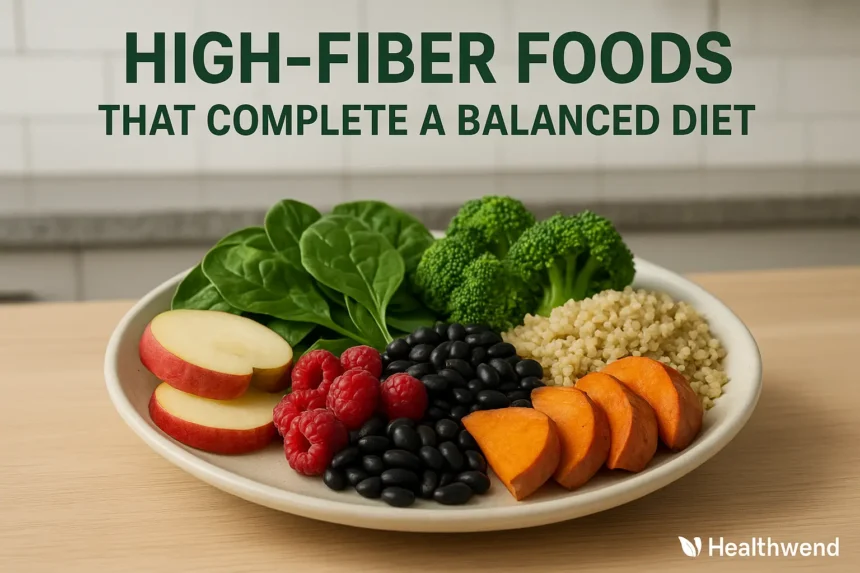A high-fiber foods balanced diet is not just about keeping your stomach full—it’s about fueling your body with nutrients that improve digestion, regulate blood sugar, and support heart health. Many people fail to get enough fiber daily, which can lead to bloating, constipation, and even long-term health issues.
This article will break down the top high-fiber foods that complete a balanced diet, explain why they’re essential, and provide practical ways to include them in your meals.
✅ Body
🍎 What Makes High-Fiber Foods Essential in a Balanced Diet?
Fiber is a type of carbohydrate that your body cannot digest, but it plays a crucial role in maintaining health:
- Supports digestive health by preventing constipation.
- Helps with weight management by keeping you full longer.
- Regulates blood sugar levels for people with diabetes.
- Lowers bad cholesterol and supports heart health.
👉 Daily Recommendation: The USDA recommends 25–38 grams of fiber per day, depending on age and gender.
🥦 Top 10 High-Fiber Foods for a Balanced Diet
1. Oats
- Rich in soluble fiber (beta-glucan) that lowers cholesterol.
- Perfect for breakfast bowls or smoothies.
2. Lentils
- Provide 16g fiber per cup cooked.
- Also high in protein, making them ideal for vegetarians.
3. Beans (Black, Kidney, Chickpeas)
- Contain 12–15g fiber per cup.
- Great for soups, salads, or burrito fillings.
4. Chia Seeds
- A superfood with 10g fiber per ounce.
- Expands in liquid, keeping you full longer.
5. Apples
- Offer 4g fiber per medium apple, mainly soluble fiber.
- Great as snacks or in salads.
6. Broccoli
- Contains both soluble and insoluble fiber.
- Also rich in antioxidants and vitamin C.
7. Quinoa
- A gluten-free grain with 5g fiber per cup cooked.
- Provides complete protein as well.
8. Berries (Raspberries, Blueberries, Strawberries)
- Raspberries have 8g fiber per cup.
- High in antioxidants for brain and heart health.
9. Sweet Potatoes
- Offer 4g fiber per medium potato.
- Also high in vitamin A for eye health.
10. Leafy Greens (Spinach, Kale, Swiss Chard)
- Not as high in fiber per serving, but nutrient-dense.
- Best when combined with beans or grains.
✅ How to Add High-Fiber Foods to Your Diet
- Breakfast: Overnight oats with chia seeds and berries.
- Lunch: Lentil soup with whole-grain bread.
- Snacks: Apple slices with peanut butter.
- Dinner: Grilled salmon with quinoa and broccoli.
👉 Tip: Increase fiber gradually and drink plenty of water to prevent bloating.
✅ Link Suggestions
- “Balanced Diet Grocery Shopping List for Beginners”
- “How Balanced Diet Impacts Mental Health and Focus”
- “Top 10 Balanced Diet Foods for Boosting Energy Levels”
✅ Another Resources Link
✅ FAQs (Schema-Ready)
Q1: What are the best high-fiber foods for weight loss?
A1: Foods like oats, chia seeds, lentils, and apples are excellent for weight loss as they keep you full longer.
Q2: How much fiber should I eat daily?
A2: Adults need between 25–38 grams per day, depending on age and gender.
Q3: Can high-fiber foods help lower cholesterol?
A3: Yes, soluble fiber in foods like oats and beans can reduce LDL (bad cholesterol).
Q4: What happens if I don’t get enough fiber?
A4: Low fiber intake can lead to constipation, digestive discomfort, and higher risk of chronic diseases.
Q5: Are high-fiber foods safe for kids?
A5: Yes, but the amount should be adjusted for age. Always combine with adequate hydration.
✅ Conclusion
A high-fiber foods balanced diet is one of the most effective ways to improve digestion, control weight, and support long-term health. By adding foods like oats, beans, fruits, and vegetables into your daily routine, you can easily meet your fiber needs.
👉 Start today by swapping refined carbs for fiber-rich alternatives. Your gut—and your overall health—will thank you!
Call-to-Action:
If you found this article useful, share it with friends and explore more tips on Healthwend.com for building a healthier lifestyle.


